door lock HONDA CIVIC COUPE 2016 10.G Quick Guide
[x] Cancel search | Manufacturer: HONDA, Model Year: 2016, Model line: CIVIC COUPE, Model: HONDA CIVIC COUPE 2016 10.GPages: 82, PDF Size: 5.2 MB
Page 3 of 82

INTRODUCTION TABLE OF CONTENTS
This Owner’s Guide is intended to help you quickly get acquainted with your
2016 Honda Civic Coupe. It provides basic information and instructions on technology
and convenience features, as well as emergency procedures and how to get assistance.
This guide is for vehicles sold in the United States and Canada. It covers all Civic Coupe models, so you may �nd descriptions of features and equipment that are not in your
vehicle. Images throughout this guide are from U.S. vehicles and represent features and equipment that are available on some, but not all, models.
This guide is not intended to be a substitute for the Owner’s Manual. The Owner
Information CD enclosed in your glove box kit includes the Owner’s Manual, Navigation
Manual, and vehicle and tire warranties in electronic format. This information can be
viewed on a computer (PC or Mac platform) and saved or printed for your reference. You can also visit owners.honda.com (U.S.) or myhonda.ca (Canada) to view the complete
and most current information.
If you are the �rst registered owner of your vehicle, you may request a complimentary
printed copy of the Owner’s Manual, Navigation Manual, or Vehicle Warranty within the
�rst six months of vehicle purchase. To request a copy, visit owners.honda.com (U.S.)
and create or log in to your account. In Canada, please request a copy from your Honda
dealer. American Honda Motor Co., Inc. strives to be proactive in protecting our environment
and natural resources. By using electronic delivery for a considerable portion of the
information typically found in a vehicle owner’s manual, we are further reducing our impact on the environment.
Honda Automobile Customer Service
Your authorized Honda dealer should be able to answer any questions you have
about your vehicle. However, if you are dissatis�ed with the information you receive, you can call Honda Automobile Customer Service (see page 150).
Phone (800) 999-1009 (U.S.) or (888) 946-6329 (Canada)
Honda Roadside Assistance
24-hour emergency road service is available to you in the United States and Canada
throughout your 3-year/36,000-mile warranty term. Services include jump starting, �at tire and lockout assistance, towing, and more (limitations apply).
Phone (866) 864-5211 (U.S.) or (800) 465-7587 (Canada)
*if equipped
Visual Index .................................... 1
Steering Wheel and Nearby Controls ................1
Dashboard, Ceiling, and Other Controls .............2
Safety Information .........................3
Important Safety Information ...............................3
Seat Belts ................................................................ 5
Airbags.....................................................................8 Child Safety ........................................................... 14
Safety Label Locations ........................................21
Reporting Safety Defects....................................22
Instrument Panel.......................... 23
Malfunction Indicators........................................24 Condition Indicators ............................................ 26
On/Off Indicators .................................................. 27
Information Display*............................................28Driver Information Interface* ............................29
Vehicle Controls ..........................31
Using the Key or Remote Transmitter* .............31
Smart Entry System* ........................................... 32
Door Operation ..................................................... 34
Power Window Operation ..................................35
Power Moonroof Operation* ............................36
One-Touch Turn Signal ........................................36
Interior and Exterior Lights .................................37
Wiper Operation ................................................... 38
Adjusting the Seats..............................................40 Adjusting the Steering Wheel ............................44
Adjusting the Mirrors .......................................... 45
Climate Control System .......................................46
Seat Heaters* ....................................................... 49
Customized Features ........................................... 50
Setting the Clock .................................................. 51
Audio and Connectivity ..............52
Basic Audio Operation ........................................52
Models with color audio system ......................57
FM/AM Radio ........................................................ 58
iPod ®
.........................................................................................................................
59
USB Flash Drive....................................................60 Bluetooth Audio ................................................... 61
Models with Display Audio ...............................62
HondaLink ®*
....................................................................................................
63
Wi-Fi Connection..................................................64Aha™ Radio .......................................................... 64
Apple CarPlay ®
...........................................................................................
65
Android Auto™ ..................................................... 66
FM/AM Radio ....................................................... 67
SiriusXM ®
Radio* ................................................. 68
iPod ®
.........................................................................................................................
69
USB Flash Drive....................................................70Bluetooth Audio ................................................... 71
Pandora ®
.............................................................................................................
72
Bluetooth Handsfreelink ............73
Basic HFL Operation ............................................ 73
Pairing a Phone .................................................... 74
Making a Call ........................................................ 75
Basic HFL Operation ............................................ 76
Pairing a Phone .................................................... 78
Making a Call ........................................................ 79
SMS Text Messaging and E-Mail* ....................80
HondaLink Assist..................................................81 Siri ®
Eyes Free ...................................................... 82
Navigation*................................... 83
Basic Navigation Operation ...............................83
Entering a Destination ......................................... 85
Routing ................................................................... 88
Page 5 of 82

2 || 3
SAFETY
VISUAL INDEX
Dashboard, Ceiling, and Other Controls
1 Color audio system* p. 57
Display Audio* p. 62
2 Hazard warning button
3 Climate control system/seat heater
buttons*
p. 45, p. 46, p. 49
4 USB port p. 52
Accessory power socket p. 52
6 Moonroof switch* p. 36
Map lights p. 37
Rearview mirror p. 45
7 Power window switches p. 35
Door lock switches p. 34
Door mirror controls p. 45
8 Trunk release button p. 34
9 Hood release handle p. 132
10 ENGINE START/STOP button*
p. 96
11 ECON button* p. 100
12 Electric parking brake switch
p. 98
Automatic brake hold button
p. 99
*if equipped
SAFETY INFORMATION
2
3
71
8
6
4
Your safety—and the safety of others—is very important, and operating this vehicle
safely is an important responsibility. While we strive to help you make informed
decisions about safety, it is not practical or possible to warn you about all the hazards associated with operating or maintaining your vehicle. Therefore, you must use your own good judgment.
Important Safety Information
This guide explains many of your vehicle’s safety features and how to use them. Please
read this information carefully. Following the instructions below will also help to keep you and your passengers safe.
Important Safety Precautions
• Always wear your seat belt.
• Secure all children in the proper restraint system.
• Be aware of airbag hazards.
• Don’t drink and drive.
• Pay appropriate attention to the task of driving safely.
• Control your speed.
• Keep your vehicle in safe condition.
Engaging in cell phone conversation or other activities that keep you from paying
close attention to the road, other vehicles, and pedestrians could lead to a crash.
Remember, situations can change quickly, and only you can decide when it is safe to divert some attention away from driving.
Safety Messages
When you see the following messages throughout this guide, pay close attention. You WILL be KILLED or SERIOUSLY HURT if you don’t follow
instructions. You CAN be KILLED or SERIOUSLY HURT if you don’t follow
instructions. You CAN be HURT if you don’t follow instructions.
This information is intended to help you avoid damage to your
vehicle, other property, or the environment.
DANGER
WARNING
CAUTION
NOTICE
5
59101112
Page 6 of 82
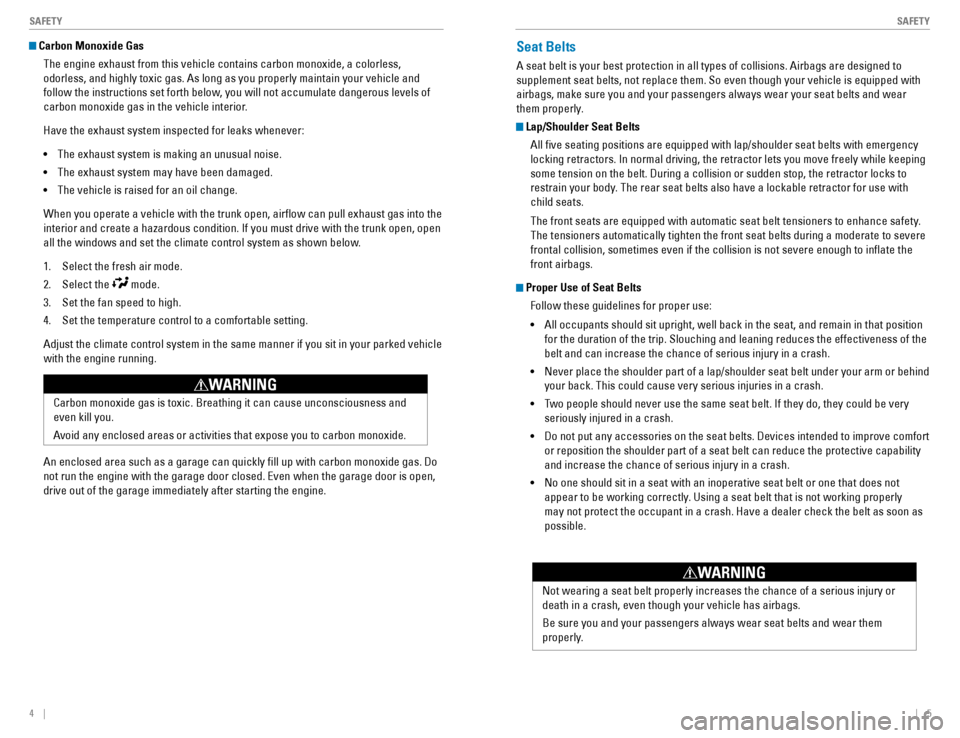
4 || 5
SAFETY
SAFETY
Carbon Monoxide Gas
The engine exhaust from this vehicle contains carbon monoxide, a colorless,
odorless, and highly toxic gas. As long as you properly maintain your vehicle and
follow the instructions set forth below, you will not accumulate dangerous levels of
carbon monoxide gas in the vehicle interior. Have the exhaust system inspected for leaks whenever:• The exhaust system is making an unusual noise.
• The exhaust system may have been damaged.
• The vehicle is raised for an oil change.
When you operate a vehicle with the trunk open, air�ow can pull exhaust gas into the interior and create a hazardous condition. If you must drive with the trunk open, open all the windows and set the climate control system as shown below.
1. Select the fresh air mode.
2. Select the
mode.
3. Set the fan speed to high.
4. Set the temperature control to a comfortable setting.
Adjust the climate control system in the same manner if you sit in your parked vehicle with the engine running. An enclosed area such as a garage can quickly �ll up with carbon monoxide gas. Do not run the engine with the garage door closed. Even when the garage door is open, drive out of the garage immediately after starting the engine.
Seat Belts
A seat belt is your best protection in all types of collisions. Airbags are designed to supplement seat belts, not replace them. So even though your vehicle is equipped with
airbags, make sure you and your passengers always wear your seat belts and wear
them properly.
Lap/Shoulder Seat Belts
All �ve seating positions are equipped with lap/shoulder seat belts with emergency
locking retractors. In normal driving, the retractor lets you move freely while keeping
some tension on the belt. During a collision or sudden stop, the retractor locks to
restrain your body. The rear seat belts also have a lockable retractor for use with child seats.
The front seats are equipped with automatic seat belt tensioners to enhance safety. The tensioners automatically tighten the front seat belts during a moderate to severe
frontal collision, sometimes even if the collision is not severe enough to in�ate the front airbags.
Proper Use of Seat Belts
Follow these guidelines for proper use: • All occupants should sit upright, well back in the seat, and remain in that position
for the duration of the trip. Slouching and leaning reduces the effectiveness of the belt and can increase the chance of serious injury in a crash.
• Never place the shoulder part of a lap/shoulder seat belt under your arm or behind
your back. This could cause very serious injuries in a crash.
• Two people should never use the same seat belt. If they do, they could be very
seriously injured in a crash.
• Do not put any accessories on the seat belts. Devices intended to improve comfort
or reposition the shoulder part of a seat belt can reduce the protective capability and increase the chance of serious injury in a crash.
• No one should sit in a seat with an inoperative seat belt or one that does not
appear to be working correctly. Using a seat belt that is not working properly may not protect the occupant in a crash. Have a dealer check the belt as soon as possible.
Carbon monoxide gas is toxic. Breathing it can cause unconsciousness and even kill you.
Avoid any enclosed areas or activities that expose you to carbon monoxide.
WARNING
Not wearing a seat belt properly increases the chance of a serious injury or death in a crash, even though your vehicle has airbags. Be sure you and your passengers always wear seat belts and wear them
properly.
WARNING
Page 11 of 82
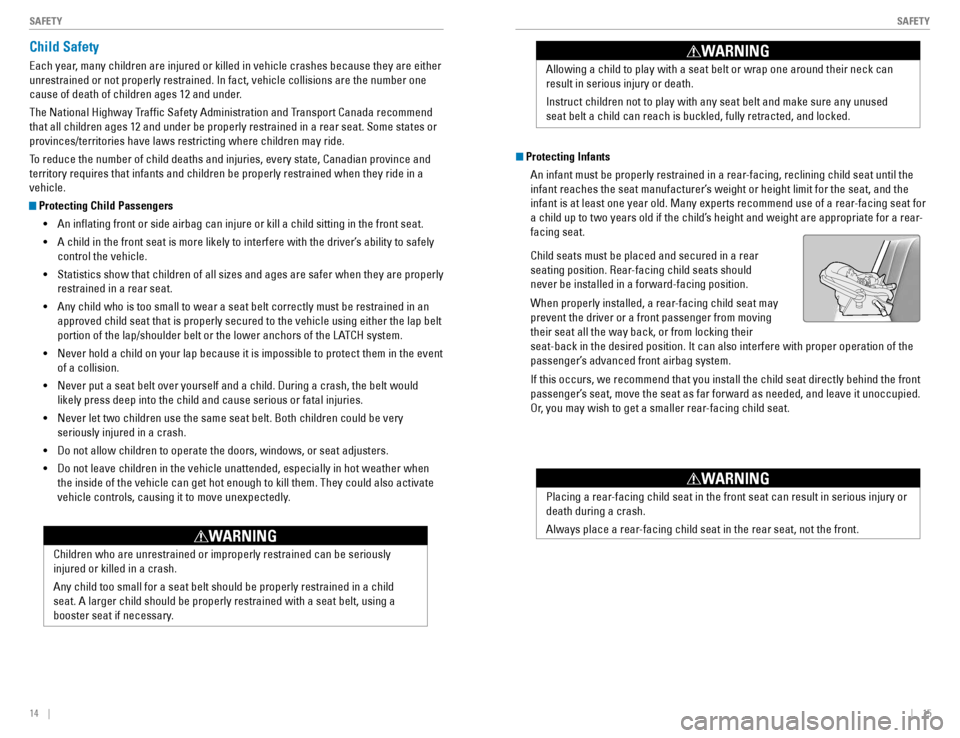
14 || 15
SAFETY
SAFETY
Child Safety
Each year, many children are injured or killed in vehicle crashes because they are either
unrestrained or not properly restrained. In fact, vehicle collisions are the number one
cause of death of children ages 12 and under.
The National Highway Traf�c Safety Administration and Transport Canada recommend
that all children ages 12 and under be properly restrained in a rear seat. Some states or provinces/territories have laws restricting where children may ride.
To reduce the number of child deaths and injuries, every state, Canadian province and territory requires that infants and children be properly restrained when they ride in a vehicle.
Protecting Child Passengers
• An in�ating front or side airbag can injure or kill a child sitting in the front seat.
• A child in the front seat is more likely to interfere with the driver’s ability to safely
control the vehicle.
• Statistics show that children of all sizes and ages are safer when they are properly
restrained in a rear seat.
• Any child who is too small to wear a seat belt correctly must be restrained in an
approved child seat that is properly secured to the vehicle using either the lap belt
portion of the lap/shoulder belt or the lower anchors of the LATCH system.
• Never hold a child on your lap because it is impossible to protect them in the event
of a collision.
• Never put a seat belt over yourself and a child. During a crash, the belt would
likely press deep into the child and cause serious or fatal injuries.
• Never let two children use the same seat belt. Both children could be very
seriously injured in a crash.
• Do not allow children to operate the doors, windows, or seat adjusters.
• Do not leave children in the vehicle unattended, especially in hot weather when
the inside of the vehicle can get hot enough to kill them. They could also activate vehicle controls, causing it to move unexpectedly.
Protecting Infants
An infant must be properly restrained in a rear-facing, reclining child seat until the
infant reaches the seat manufacturer’s weight or height limit for the seat, and the
infant is at least one year old. Many experts recommend use of a rear-facing seat for
a child up to two years old if the child’s height and weight are appropriate for a rear-facing seat. Child seats must be placed and secured in a rear
seating position. Rear-facing child seats should never be installed in a forward-facing position.
When properly installed, a rear-facing child seat may prevent the driver or a front passenger from moving their seat all the way back, or from locking their seat-back in the desired position. It can also interfere with proper operation of the
passenger’s advanced front airbag system.
If this occurs, we recommend that you install the child seat directly behind the front
passenger’s seat, move the seat as far forward as needed, and leave it unoccupied.
Or, you may wish to get a smaller rear-facing child seat. Allowing a child to play with a seat belt or wrap one around their neck can result in serious injury or death.
Instruct children not to play with any seat belt and make sure any unused seat belt a child can reach is buckled, fully retracted, and locked.
WARNING
Children who are unrestrained or improperly restrained can be seriously injured or killed in a crash. Any child too small for a seat belt should be properly restrained in a child
seat. A larger child should be properly restrained with a seat belt, using a
booster seat if necessary.
WARNING
Placing a rear-facing child seat in the front seat can result in serious injury or death during a crash.
Always place a rear-facing child seat in the rear seat, not the front.
WARNING
Page 19 of 82

30 || 31
VEHICLE CONTROLS
INSTRUMENT PANEL
Vehicle Settings
You can customize certain features when the vehicle is stopped.
MENU/CLOCK Button
Audio/Info
rmation Screen
Selector Knob
(Phone) Button
Audio/Information Touch Screen
VEHICLE CONTROLS
*if equipped
Learn about the various controls necessary for operating and driving the vehicle.
Using the Key or Remote Transmitter*
Lock or unlock the doors and trunk.
Unlock button:
Press once to
unlock the driver’s door. Press again to unlock all doors.
Trunk button: Press and
hold to unlock and open the trunk.
Lock button: Press to lock
the doors. Press again for audible veri�cation.
Panic button: Press to
sound the alarm for 30 seconds. Press again to cancel.
Built-in key*: Slide the
release knob on the back of the transmitter and
pull out the built-in key.
Release knob
Built-in key
Leaving the key or remote transmitter in the vehicle can result in theft or accidental
movement of the vehicle. Always take it with you whenever you leave the vehicle unattended.
NOTICE
Engine button*: Remotely start
the engine (see page 94).
Models with Information Display
Models with Driver Information Interface
Page 20 of 82
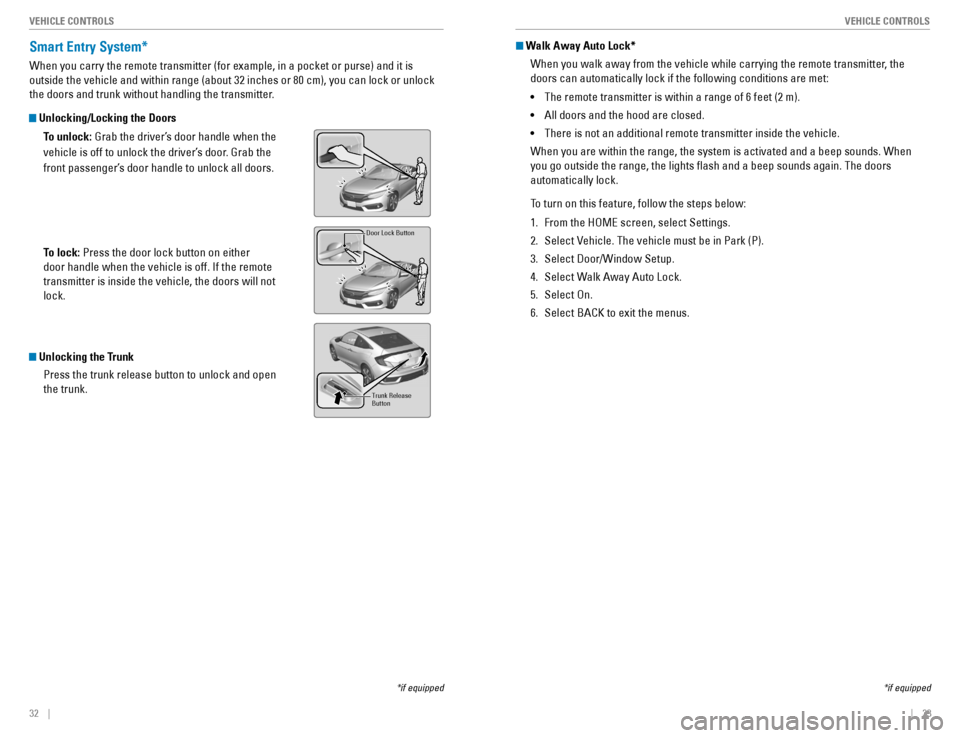
32 || 33
VEHICLE CONTROLS
VEHICLE CONTROLS
Smart Entry System*
When you carry the remote transmitter (for example, in a pocket or purse) and it is
outside the vehicle and within range (about 32 inches or 80 cm), you can lock or unlock
the doors and trunk without handling the transmitter.
Unlocking/Locking the Doors
To unlock: Grab the driver’s door handle when the
vehicle is off to unlock the driver’s door. Grab the
front passenger’s door handle to unlock all doors.
To lock: Press the door lock button on either
door handle when the vehicle is off. If the remote transmitter is inside the vehicle, the doors will not lock.
Unlocking the Trunk
Press the trunk release button to unlock and open the trunk.
*if equipped
Door Lock Button
ButtonTrunk Release
Walk Away Auto Lock*
When you walk away from the vehicle while carrying the remote transmitter, the doors can automatically lock if the following conditions are met: • The remote transmitter is within a range of 6 feet (2 m).
• All doors and the hood are closed.
• There is not an additional remote transmitter inside the vehicle.
When you are within the range, the system is activated and a beep sounds. When you go outside the range, the lights �ash and a beep sounds again. The doors automatically lock.
To turn on this feature, follow the steps below:
1. From the HOME screen, select Settings.
2. Select Vehicle. The vehicle must be in Park (P).
3. Select Door/Window Setup.
4. Select Walk Away Auto Lock.
5. Select On.
6. Select BACK to exit the menus.
*if equipped
Page 21 of 82
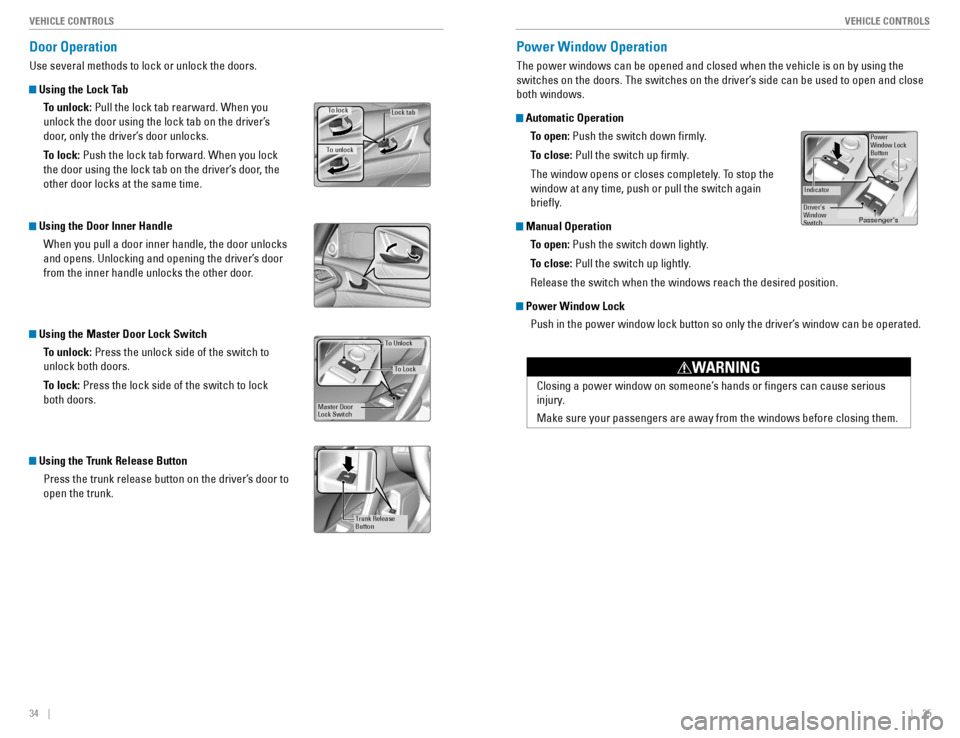
34 || 35
VEHICLE CONTROLS
VEHICLE CONTROLS
Door Operation
Use several methods to lock or unlock the doors.
Using the Lock Tab
To unlock: Pull the lock tab rearward. When you
unlock the door using the lock tab on the driver’s
door, only the driver’s door unlocks.
To lock: Push the lock tab forward. When you lock
the door using the lock tab on the driver’s door, the other door locks at the same time.
Using the Door Inner Handle
When you pull a door inner handle, the door unlocks
and opens. Unlocking and opening the driver’s door
from the inner handle unlocks the other door.
Using the Master Door Lock Switch
To unlock: Press the unlock side of the switch to
unlock both doors.
To lock: Press the lock side of the switch to lock
both doors.
Using the Trunk Release Button
Press the trunk release button on the driver’s door to open the trunk.
To unlock
Lock ta bTo lock
To Unlock
Lock Switch
Master Door
To Lock
Trunk Release Butto
n
Power Window Operation
The power windows can be opened and closed when the vehicle is on by using the
switches on the doors. The switches on the driver’s side can be used to open and close both windows.
Automatic Operation
To open: Push the switch down �rmly.
To close: Pull the switch up �rmly.
The window opens or closes completely. To stop the window at any time, push or pull the switch again
brie�y.
Manual Operation
To open: Push the switch down lightly.
To close: Pull the switch up lightly.
Release the switch when the windows reach the desired position.
Power Window Lock
Push in the power window lock button so only the driver’s window can be operated.
Power Window Lock
Button
Indicator
Driver’s Switch
Window Passenger’s Window Switch
Closing a power window on someone’s hands or �ngers can cause serious
injury.
Make sure your passengers are away from the windows before closing them.
WARNING
Page 22 of 82
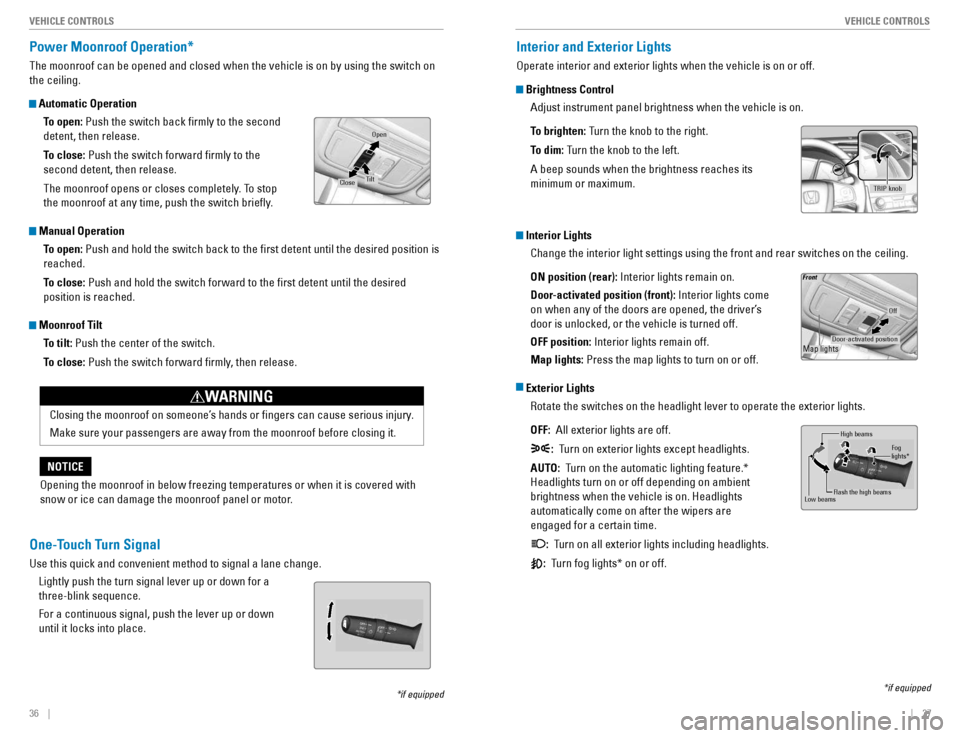
36 || 37
VEHICLE CONTROLS
VEHICLE CONTROLS
Power Moonroof Operation*
The moonroof can be opened and closed when the vehicle is on by using the switch on the ceiling.
Automatic Operation
To open: Push the switch back �rmly to the second
detent, then release.
To close: Push the switch forward �rmly to the
second detent, then release.
The moonroof opens or closes completely. To stop
the moonroof at any time, push the switch brie�y.
Manual Operation
To open: Push and hold the switch back to the �rst detent until the desired position is
reached.
To close: Push and hold the switch forward to the �rst detent until the desired
position is reached.
Moonroof Tilt
To tilt: Push the center of the switch.
To close: Push the switch forward �rmly, then release.
*if equipped
Open
CloseTilt
Opening the moonroof in below freezing temperatures or when it is covered with
snow or ice can damage the moonroof panel or motor.
NOTICE
Closing the moonroof on someone’s hands or �ngers can cause serious injury. Make sure your passengers are away from the moonroof before closing it.
WARNING
Interior and Exterior Lights
Operate interior and exterior lights when the vehicle is on or off.
Brightness Control
Adjust instrument panel brightness when the vehicle is on.
To brighten: Turn the knob to the right.
To dim: Turn the knob to the left.
A beep sounds when the brightness reaches its minimum or maximum.
Interior Lights
Change the interior light settings using the front and rear switches on the ceiling. ON position (rear): Interior lights remain on.
Door-activated position (front): Interior lights come
on when any of the doors are opened, the driver’s door is unlocked, or the vehicle is turned off. OFF position: Interior lights remain off.
Map lights: Press the map lights to turn on or off.
Exterior Lights
Rotate the switches on the headlight lever to operate the exterior lights. OFF: All exterior lights are off.
: Turn on exterior lights except headlights.
AUTO: Turn on the automatic lighting feature.*
Headlights turn on or off depending on ambient brightness when the vehicle is on. Headlights automatically come on after the wipers are engaged for a certain time. : Turn on all exterior lights including headlights.
: Turn fog lights* on or off.
*if equipped
TRIP knob
Door-activated position
Off
Fron t
Map lights
High beams
Flash the high beams
Low beams
Fog lights*
One-Touch Turn Signal
Use this quick and convenient method to signal a lane change.
Lightly push the turn signal lever up or down for a three-blink sequence. For a continuous signal, push the lever up or down until it locks into place.
Page 26 of 82

44 || 45
VEHICLE CONTROLS
VEHICLE CONTROLS
Adjusting the Mirrors
Adjust the angle of the mirrors for the best visibility when you are sitting in the correct driving position.
Rearview Mirror with Day/Night Positions*
Manually adjust the position to reduce headlight glare from vehicles behind you. Flip the tab to switch between day and night positions.
Automatic Dimming Rearview Mirror*
When driving after dark, the automatic dimming function reduces the glare from headlights behind
you based on the mirror sensor. The function cancels when the shift lever is in Reverse (R).
Power Door Mirrors
Adjust the power door mirrors when the vehicle is on. L/R selector switch: Select the left or right mirror.
After adjusting the mirror, return the switch to the center position. Mirror position adjustment switch: Press the switch
left, right, up, or down to move the mirror.
Tab
Daytime position
Night position
*if equipped
Selector
switchAdjustment
switch
Sensor
Adjusting the Steering Wheel
The steering wheel height and distance from your body can be adjusted so that you can comfortably grip the steering wheel in an appropriate driving posture.
• Pull up the steering wheel adjustment lever.
• Move the steering wheel up or down, and in or out.
• Push down the steering wheel adjustment lever to
lock the steering wheel in position.
Adjusting the steering wheel position while driving may cause you to lose control of the vehicle and be seriously injured in a crash. Adjust the steering wheel only when the vehicle is stopped.
WARNING
To adjust To lock Lever
Page 49 of 82

90 || 91
DRIVING
DRIVING
DRIVING
Learn about preparation for driving, as well as other features.
Before Driving
Check the following items before you begin driving.
Exterior Checks
• Make sure there are no obstructions on the windows, door mirrors, exterior lights,
or other parts of the vehicle.
• Remove any frost, snow, or ice.
• Make sure the hood is securely closed.
• Heat from the engine and exhaust can ignite �ammable materials left under the
hood, causing a �re. If you’ve parked your vehicle for an extended period, inspect and remove any debris that may have collected, such as dried grass and leaves
that have fallen or have been carried in for use as a nest by a small animal. Also
check under the hood for leftover �ammable materials after you or someone else has performed maintenance on your vehicle.
• Make sure the tires are in good condition.
• Make sure there are no people or objects behind or around the vehicle.
If the doors are frozen shut, use warm water around the door edges to melt any ice. Do not try to force them open, as this can damage the rubber trim around the doors. When done, wipe dry to avoid further freezing.
NOTICE
In addition: • During the �rst 600 miles (1,000 km) of operation, avoid sudden acceleration or full
throttle operation so as not to damage the engine or powertrain.
• Avoid hard braking for the �rst 200 miles (300 km). You should also follow this when
the brake pads are replaced.
Improper accessories or modi�cations can affect your vehicle’s handling,
stability, and performance, and cause a crash in which you can be seriously hurt or killed.
Follow all instructions in the vehicle owner’s manual regarding accessories and modi�cations.
WARNING
Interior Checks
• Store or secure all items on board properly.
• Do not place anything in the front-seat footwells. Make sure to secure the �oor
mats.
• If you have any animals on board, do not let them move freely around in the
vehicle.
• Securely close and lock all doors and the trunk.
• Adjust your seating position, mirrors, and steering wheel properly.
• Make sure items placed on the �oor behind the front seats cannot roll under the
seats.
• Everyone in the vehicle must fasten their seat belt.
• Make sure that the indicators in the instrument panel come on when you start the
vehicle, and go off soon after.